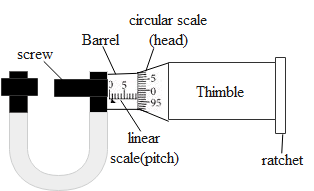
Explain the working principle of the screw gauge.
Answer
570.9k+ views
Hint: Screw gauge is a measuring instrument that is used to measure the diameter of a thin wire or the width of a metal sheet. It consists of a U-shaped fixed mount on a screwed pin which is fixed to a thimble, barrel, spindle, and a Ratchet.
Complete answer:
A screw gauge is an instrument that is used to measure the width of a thin sheet and thickness of a wire.it is also used to measure the dimension of spherical and cylindrical objects. The following diagram shows the components of the screw gauge.

The screw gauge has two scales, one is the key scale and another is termed as an additional scale. The key scale (linear scale) is in millimeters scale passed to 0.5mm and the additional scale (circular scale) is split into 50 uniform divisions.
The screw gauge works on the principle of movement. When the screw is rotated, there is a linear motion on the main scale of the screw gauge. This measurement is used to calculate small lengths.
The distance moved by the spindle per rotation is known as pitch. It is measured by rotating the head scale per the pitch scale to complete one rotation.
Pitch = distance moved by the screw / given no of rotations
The least count of a screw gauge is the distance moved by the tip of the screw when moved through one division of the scale.
Least count = pitch/ total no of division on a circular scale.
The least count of screw gauge is 0.01 millimeter.
Note:
While using a screw gauge we have to take reading very precisely. As it is a manual instrument there are high chances of human errors. Screw gauge provides the exact dimension of the object as it is in direct contact with the surface of the object.
Complete answer:
A screw gauge is an instrument that is used to measure the width of a thin sheet and thickness of a wire.it is also used to measure the dimension of spherical and cylindrical objects. The following diagram shows the components of the screw gauge.

The screw gauge has two scales, one is the key scale and another is termed as an additional scale. The key scale (linear scale) is in millimeters scale passed to 0.5mm and the additional scale (circular scale) is split into 50 uniform divisions.
The screw gauge works on the principle of movement. When the screw is rotated, there is a linear motion on the main scale of the screw gauge. This measurement is used to calculate small lengths.
The distance moved by the spindle per rotation is known as pitch. It is measured by rotating the head scale per the pitch scale to complete one rotation.
Pitch = distance moved by the screw / given no of rotations
The least count of a screw gauge is the distance moved by the tip of the screw when moved through one division of the scale.
Least count = pitch/ total no of division on a circular scale.
The least count of screw gauge is 0.01 millimeter.
Note:
While using a screw gauge we have to take reading very precisely. As it is a manual instrument there are high chances of human errors. Screw gauge provides the exact dimension of the object as it is in direct contact with the surface of the object.
Recently Updated Pages
Master Class 12 Business Studies: Engaging Questions & Answers for Success

Master Class 12 Economics: Engaging Questions & Answers for Success

Master Class 12 English: Engaging Questions & Answers for Success

Master Class 12 Maths: Engaging Questions & Answers for Success

Master Class 12 Social Science: Engaging Questions & Answers for Success

Master Class 12 Chemistry: Engaging Questions & Answers for Success

Trending doubts
What is meant by exothermic and endothermic reactions class 11 chemistry CBSE

Which animal has three hearts class 11 biology CBSE

10 examples of friction in our daily life

One Metric ton is equal to kg A 10000 B 1000 C 100 class 11 physics CBSE

1 Quintal is equal to a 110 kg b 10 kg c 100kg d 1000 class 11 physics CBSE

Difference Between Prokaryotic Cells and Eukaryotic Cells




